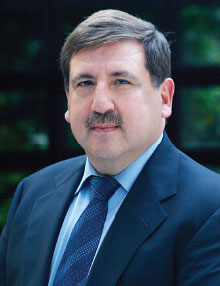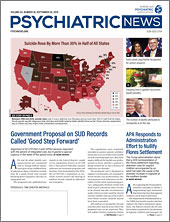A 13-year-old student from South Carolina described being pressured into going to a religious-based “conversion therapy” camp by his parents and his church after struggling with his gender identity. There he was shamed and told how awful and sinful were his actions, thoughts, and desires. Some of his peers were given electric shocks while being shown pornographic images depicting same-sex couples. The patient now identifies as a transgender man and is considering transitioning, although he still has negative flashbacks of his treatment.
Unfortunately, this patient’s experiences are not unusual at faith-based “conversion therapy” programs, which are typically led by unlicensed counselors, explained Jacques Ambrose, M.D., a child and adolescent psychiatrist at Massachusetts General Hospital/Harvard Medical School.
Conversion therapy is an intervention aimed at changing an individual’s sexual orientation or behavior, also known as sexual orientation change efforts (SOCE). The term gender identity change efforts (GICE) has recently arisen from the same thought process and targets individuals with nonbinary or nontraditional gender identity. Both are based on the harmful and incorrect assumptions that homosexuality and transgenderism are mental disorders—or are sinful—and that the patients can and must change these behaviors.
“In the 1980s and 1990s, the general belief in our profession was that there was no harm in trying talk therapy to help patients who wanted to change their sexual orientation,” explained Jack Drescher, M.D. Among other positions, he is a clinical professor of psychiatry at Columbia University and a member of the World Health Organization’s Working Group on the Classification of Sexual Disorders and Sexual Health revising ICD-11, and he served on the DSM-5 Work Group on Sexual and Gender Identity Disorders. “However, evidence has shown that not only do such change efforts fail, but they can also lead to depression, guilt and shame, substance use disorders, failed heterosexual marriages, and suicide.”
“When people enter these treatments, they are told that their success depends on them and their faith,” Drescher explained. “It means that the failure of the treatment is laid at their feet. It’s not that the therapy didn’t work or that God didn’t want it to work or that the therapist is unqualified. It’s the patients’ fault. So patients end up feeling worse than when they started, and on top of that, they still have sexual feelings that they don’t want to have.”
Ambrose said aversive conditioning is sometimes used in conversion therapy, such as restraint and electroshock, deprivation of food and liquids, smelling salts, and chemically induced nausea; masturbation reconditioning; and systematic densensitization.
“They essentially torture people after exposing them to certain stimuli,” he said. “Patients who have been exposed to these therapies often report significant symptoms of trauma. These SOCE/GICE practices have no evidence of efficacy, can actually hurt people, and further stigmatize legitimate mental health care for this vulnerable population.”
Some 11 million adults identify as LGBT individuals in the United States, and nearly 700,000 of them are estimated to have received treatment to change their sexual orientation or identity, according to data from the UCLA Williams Institute on Sexual Orientation and Gender Identity Law and Public Policy. Two-thirds of LGBTQ youth reported that someone tried to convince them to change their sexual orientation or gender identity, according to a survey report in 2019 by the Trevor Project. Youth who have undergone conversion therapy were more than twice as likely to attempt suicide as those who did not, the report noted.
Technology Fuels Spread of Therapy
The proliferation of digital technology, such as apps and websites, have enabled targeted discriminations toward LGBTQ individuals. For instance, Facebook came under fire last year when LGBTQ users complained that their feeds were inundated with offers for for-profit conversion therapy programs. Similarly, Google recently reported its removal of conversion therapy ads in its searches. Amazon announced in July it would stop selling books by the late Joseph Nicolosi, the so-called “father of reparative therapy,” author of books such as A Parent’s Guide to Preventing Homosexuality.
Nonetheless, digital technology has also empowered community building and political activism within the LGBTQ communities and serves as an outlet of self-empowerment for affected LGBTQ individuals: they have been able to share their conversion therapy survival stories on YouTube and find their communities on Reddit/Tumblr.
“As technology becomes more integrated with our daily lives, clinicians and medical organizations should be mindful of technological resources and their pitfalls in order to better support their LGBTQ patients,” Ambrose said.
State Laws Ban Therapy for Minors
Politically, the tide is turning against conversion therapy, at least in the United States. In 2012 California became the first state to ban conversion therapy for minors, and now a total of 18 states, plus the District of Columbia and Puerto Rico, ban the practice for minors. Many more states have introduced similar legislation. Twenty years ago, APA issued its first official position statement condemning reparative or conversion therapy, a position that has been refined and strengthened over the years. The American Psychological Association, American Medical Association, National Mental Health Association, and American Academy of Pediatrics are also among those that have spoken out against these misguided attempts to “cure” individuals who are LGBTQ.
Both Drescher and Ambrose said that APA’s support of its district branches and state associations is critical, along with educating psychiatrists about the harms of conversion therapy, to secure more widespread passage of these bans. A major shortcoming of these state laws is that they apply only to licensed therapists and only when the conversion therapy is aimed at minors.
“Its practitioners are usually nonlicensed and quite marginal, with a few exceptions,” Drescher said. “So the laws don’t apply to them.”
Another avenue for advocacy includes the passage of stronger consumer protection laws, Drescher said. In 2015, the New Jersey Superior Court ruled against a conversion therapy outfit known as JONAH (Jews Offering New Alternatives to Homosexuality), finding it liable for unconscionable business practices and violating the New Jersey Consumer Fraud Act. Defendants testified that during their treatments at JONAH, they were blindfolded and pummeled with basketballs, bound with duct tape, rolled up into blankets, and subjected to anti-gay slurs.
In June, Rep. Ted Lieu (D-Calif.) introduced HR 3570, The Therapeutic Fraud Prevention Act of 2019, which would ban commercial conversion therapy on any person nationwide and curtail most forms of advertising for it. It has strong support from Democrats.
APA is backing a broader antidiscrimination bill, HR 5, the Equality Act, which would clarify the definition of gender-based discrimination under existing civil rights laws to include discrimination on the basis of sexual orientation and gender identity. It passed the House in May after several Republicans broke party ranks to vote for it, but the bill’s route to passage in the Senate remains unclear. ■
APA’s latest position statement on conversion therapy is posted
here. A news release on The Therapeutic Fraud Prevention Act is posted
here. A map of conversion therapy laws is posted
here. The Trevor Project Survey Results are posted
here.


